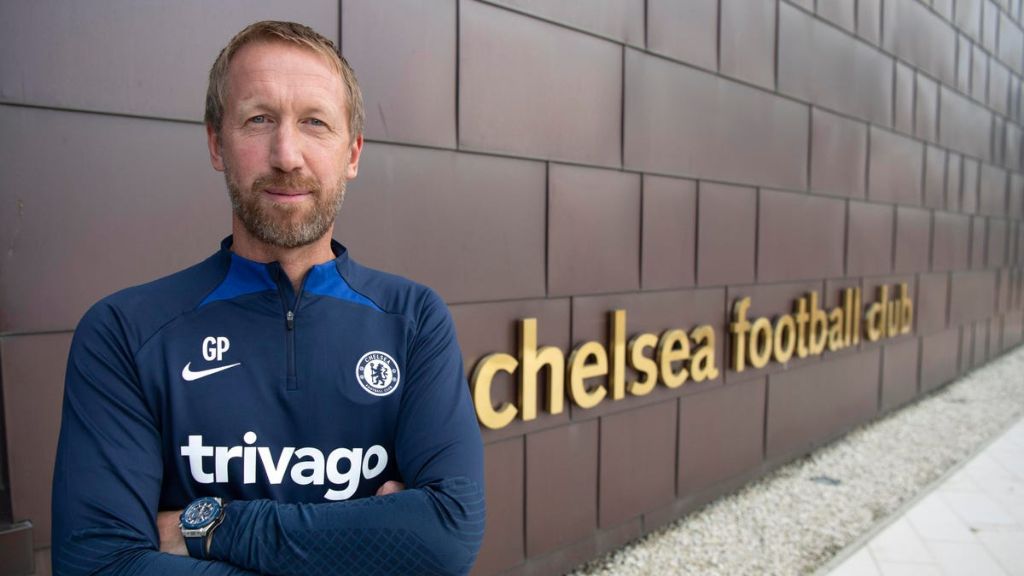Graham Potter’s man-management skills and tactics while at Brighton made him a football hipster’s hero.
His arrival at Chelsea seemed like a logical progression in a career that has so far only moved upwards.
Despite having an incredible squad at his disposal, the results have been below par. I’ve particularly surprised by the team’s lack of passion and creative ideas.
Might the manager’s tactics explain this slump? Let’s look at what Potter has brought over from his days managing Brighton and the tactics he has been working to develop for the Blues.
Potter’s career pre-Chelsea
Graham Potter has been a favorite of tactics nerds for some time now. A former West Bromwich Albion player, Potter came to prominence as the manager of Swedish side Ostersund. He managed to promote the team all the way from the fourth tier into the top flight, winning the Swedish cup and recording impressive European victories in the process.
Next, he managed Swansea before heading over to Brighton & Hove Albion who Potter helped transform into one of the best Premier League clubs outside of the Top Six.
Graham Potter describes his main ideas about football in the following way:
It’s always about the players, about putting the players in the position that you think they can influence the game the most in.
Of course, that boils down to how you see the game and how the game goes, but obviously we know it’s football and the scoreline can go against you or things can look a little bit different. That’s always the idea, to keep a consistency in terms of how we’re playing and how the team looks depending on the players we have, depending on the capability of the team we’re playing.
Potter’s football philosophy
It is not easy to figure out Potter’s setup simply by glancing at the team’s lineup before a match. Chelsea fans are by now aware of the numerous changes that occur during the game. The formations can look very different depending on which phase they are in and which team holds possession.
This is the way that the manager has always set up his teams. Potter wants his players to feel comfortable in changing roles and structures within matches. He also wants them to be able to think for their own. According to him, he was pleased with the ease with which Chelsea’s players have absorbed his instructions. The previous manager Thomas Tuchel was another coach who valued tactical flexibility.
Take, for example, Swedish side Ostersund, Potter’s first important tactical task. They went from being a fourth-tier provincial minnow to a European football success tale in seven years. He preferred a 4-4-2 formation with one of the two strikers dropping deeper to make a 4-2-3-1. The wingers pushed tended to push higher, and the fullbacks made supporting runs from behind.
Potter began to show greater variety in his formations towards the end of his time living in Sweden. Three-at-the-back systems were often preferred to counter superior opponents. He prefers to control the width with a 3-4-2-1 formation.
Potter’s tactical flexibility
Potter’s vision is frustrating to some precisely because it is difficult to interpret off the bat. Chelsea has few consistent strategies and have no clear rules of play. For the moment, the lack of a clear structure appears to be creating confusion and disorganization in every phase. The World Cup break hasn’t done the team any favors either.
It’s not unusual for Gallagher, Mount, and Ziyech to fight for the same position in attack. This occasionally leaves Kai Havertz struggling to understand his role. As Chelsea press, they often leave too many gaps. Still, Potter may still have time to change things around provided that his players develop a greater understanding of his principles.
Chelsea in defense
Potter defends by putting the team in a low-to-medium block. This thickens the lines, limits space, and limits the play on the flanks.
No matter what formation is used, the distance between lines is always minimal. Players compact the space and position their bodies very close together.
Sometimes, high pressing can transform the back five into a back three. They move in a tight block regardless of which formation they choose, with at least one player slightly deeper to aid the defense.
Also, Potter’s teams excel at committing fouls at just the right moment. It’s not unusual for Potter’s men will often give away a foul to help players recover and get ready to defend in a potentially dangerous situation.
Since their defeat to Brighton, Chelsea’s defense has been abysmal. This is not a problem of poor organization or lack of proper implementation of their best defense. It’s also a matter of personnel, in my opinion.
It is possible that injuries played a role, but I believe that Potter must also learn to drop players who are not performing to their regular standard. Manchester United’s Erik Ten Haag has proven the importance of this.
Chelsea during the build-up phase
Potter’s teams like to stretch the pitch in the build-up phase and create numerous passing avenues. With Brighton, for example, he used two central midfielders. By creating triangles with the defense players, the central midfield pair provided a solid foundation.
Brighton was, however, not a team that needed to have the ball the majority of the time.
At Chelsea, Potter in midfield must create the right chemistry between Mason Mount and players like Jorginho or Connor Gallagher. It will be a struggle to get these players to continue their development not only as offensive players but also as contributors to the team’s defense.
Chelsea in attack
Brighton’s attacks were swift and aggressive. After a possession turnover, they would quickly counterattack and exploit the gaps left by the opposition.
In Potter’s teams, the attack is supported by quick, attacking wingbacks. The wide attacking players often look to take up space centrally and to link play with the striker or wingbacks. Alexis Mac Allister, Leandro Trossard and Marc Cucurella played a major role in creating this cohesiveness. This is, perhaps, one of the main reasons why the latter was brought into Stamford Bridge.
Kai Havertz is a very gifted player capable of playing numerous roles and in numerous positions. For the time being, he is used as an advanced forward. Under Thomas Tuchel, Havertz would often be deployed as a False 9.
Havertz likes to drift into wide areas and contribute to the build-up play. Still, at times, he’s rewarded Potter’s belief in him, performing marvelously as a Classic number 9.
There is also a natural sense of excitement about new signing Mykhailo Mudryk and about former Manchester City winger Raheem Sterling whom Chelsea signed at the start of the season.
Fortunately for Potter, Chelsea’s owner Todd Boehly has sent a clear message that money is no problem.
Potter as manager of Chelsea beyond 2023?
While Chelsea’s fans may be upset with the team’s recent results, some struggles were to be expected.
Potter is new to the role as manager of a top side. He has, however, proven to be one of the best tactical minds of the last decade. Competing against the likes of Pep Guardiola and Jurgen Klopp was never going to be immediately easy.
With more time made available, and a bit of luck, it’s likely we’ll see Potter at the highest level for a while still.














